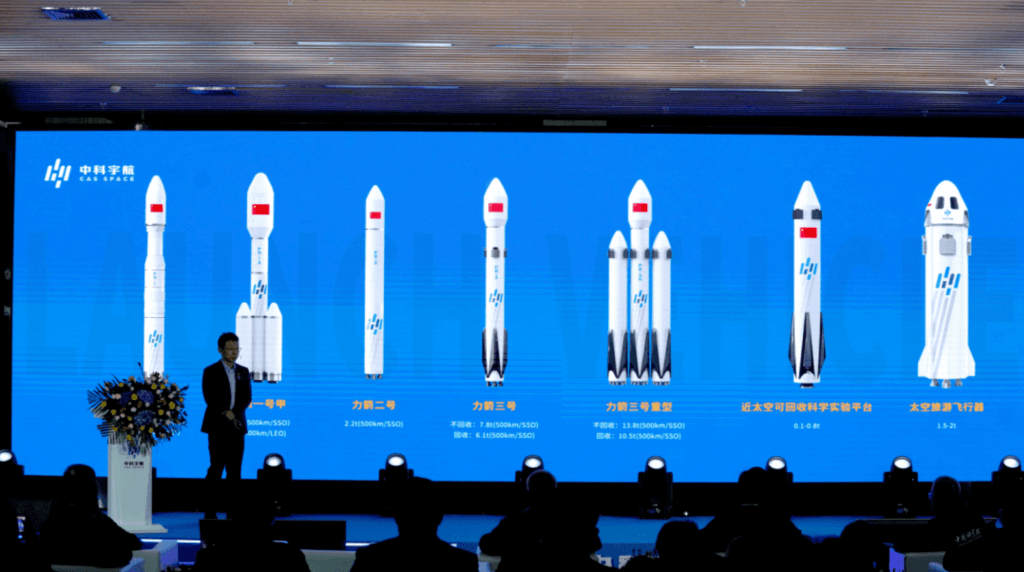HELSINKI — A Chinese space launch company has outlined its plans for a series of solid and reusable rockets for launch services and space tourism and opened a new industrial base.
CAS Space held an opening ceremony Jan. 10 for the first phase of its CAS Space Industrial Base rocket manufacturing facility in Nansha district of the southern city of Guangzhou.
The base will be capable of an output of 30 rockets per year, according to the firm.
Final assembly and testing of the company’s second Lijian-1 solid rocket is underway at the facility, targeting a May launch from the Jiuquan spaceport in northwest China.
The first Lijian-1 rocket successfully launched six satellites into orbit in July last year. CAS Space plans three Lijian-1 launches in 2023 and the rocket has recently been approved for launch from a mobile sea platform using facilities at Haiyang in Shandong province.
Shikong Tansuo, a space arm of automaker Geely Technology Group, has also settled in Nansha, following a 2021 move by the local government to attract space companies at all stages of the supply chain to the area.
Chinese launch firm CAS Space announces progress on its 40-hectare complex in Nansha district in Guangzhou. The development is part of a drive to make the city one of China’s major space clusters.https://t.co/kbAqQ5dOZq pic.twitter.com/K67e9FmGSp
— Andrew Jones (@AJ_FI) March 23, 2022
CAS Space, sometimes referred to as Zhongke Aerospace, is a commercial spinoff from the Chinese Academy of Sciences (CAS).
It is developing a series of launchers known as Lijian, or PR, rockets, including reusable liquid propellant launchers. A presentation of the series Jan.10 shows lighter solid rockets, shifting to reusable launchers and a rocket for suborbital tourism. The firm is also aiming to have its rockets be selected as backup for cargo transportation to China’s Tiangong space station.
The designs have been noted online for their apparent resemblance to the SpaceX Falcon 9, the triple-core Falcon Heavy and the Blue Origin New Shepard crew capsule. The Lijian-1 rocket also has similarities with the Jielong-3 rocket developed by CASC. CAS previously flew only sounding rockets before a 2014 opening of the Chinese space sector to other sources of capital.
The largest and most capable planned rocket is the Lijian-3/PR-3 heavy lift rocket, able to send 13.8 tons to a 500-kilometer-altitude sun-synchronous orbit in expendable mode or 10.5 tons to the same orbit when the boosters are recovered for reuse, according to a presentation at the 9th China (International) Commercial Aerospace Forum in late December.
The 50-meter-long rocket will have three, 3.8-meter-diameter core stages, no apparent second stage, and be powered by Xuanyuan gas generator kerosene-liquid oxygen engines. CAS Space is targeting 2026 for an inaugural launch.
The company revealed Jan. 10 that it already has a number of launch contracts signed worth US$237 million. The contracts are with seven customers for launching 200 satellites with a total mass of 40 metric tons. Customers include Beijing-based low Earth orbit communications satellite maker Commsat.
CAS Space raised $31 million in 2021 but leading investors were CITIC Juxin, ultimately owned by state-owned investment company CITIC Group Corporation, Zhongke Chuangxing, an accelerator fund set up by CAS, and Yuexiu Industrial Investment, another state-owned investment vehicle, operating in the Guangdong-Hong Kong-Macao Greater Bay Area.
While the China Aerospace Science and Technology Corporation (CASC) launches almost all of China’s civilian and military missions, CAS Space joins another major state-owned giant spinoff, Expace, in fighting for commercial contracts.
It also faces competition from other emerging Chinese commercial launch service providers including Galactic Energy, Landspace, iSpace, Deep Blue Aerospace, Space Pioneer, Orienspace and Rocket Pi.

